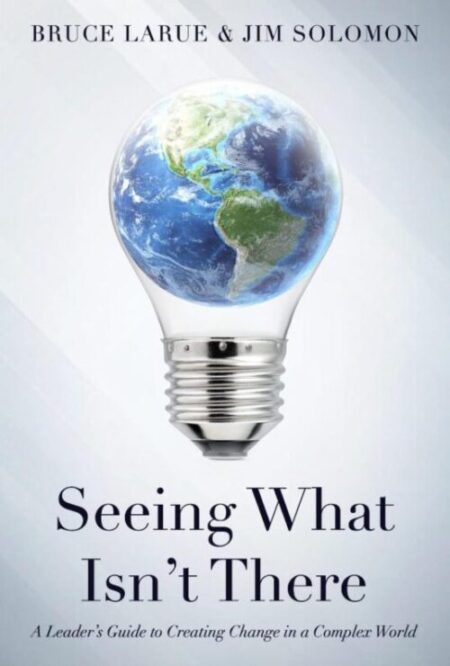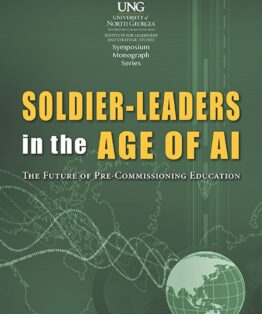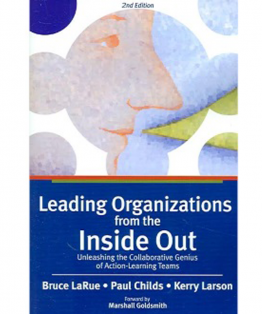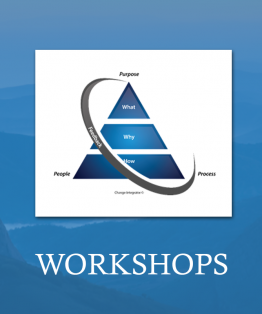Description
Great leaders have the ability to see what isn’t there and inspire others with their vision to create the greatest achievements of our time. These leaders don’t react to change, they create it. This book helps leaders see a future yet to be born while showing you how to channel the collective energy of others to make it a reality. The authors provide vivid examples of how to lead change from their vast global reservoir of experience advising leaders within some of the most complex organizations in the world today. Whether you are launching a strategic initiative, improving procedures, creating an internal development path for your workers, reinforcing your cyber defenses, building a new urban center, rebooting your country, or you simply want to become a more effective leader, leadership is about leading change — and this book shows you how to do it.





milmedia –
“Congratulations to LaRue and Solomon for offering leaders a clear and highly effective guide to inspiring today’s knowledge workforce! Their innovative and practical tools allow us to achieve a team environment that every organization needs. Examples of successful ‘Integrator-Leaders’ at different levels, occupations, and nationalities will motivate all of us to give their publication serious and rewarding consideration.”
Dr. Robert Ivany
President Emeritus
University of St Thomas
milmedia –
“For over 50 years, I’ve been a student and practitioner of leadership. I’ve managed large grocery stores, been the CEO of a 400-bed hospital, served as the Chairman or President of several non-profit boards, and been the COO of a multi-billion-dollar world-wide healthcare enterprise. I’ve read everything from the classics of Drucker to the comics of Dilbert and lots in between. Few books provide a message as clear and relevant to today’s challenging world as Seeing What Isn’t There. Written from a practitioner’s point of view, the authors’ real-world examples and vignettes bring life to the principles they share. Play close attention to the discussion of the “Change Integrator.” This simple, but effective, model is, in my opinion, the major take-away of the book. Applicable to leaders at all levels, rookies and seasoned pros, this book is a must read for leaders in organizations undergoing a change initiative. I’ve had the pleasure of knowing and working with Jim Solomon for nearly 30 years. There are few leaders with Jim’s vision and skill. Read this book and you will learn to see the world in new ways—something that leaders must learn to do.”
Herbert A. Coley
Senior Executive Service (Retired)
Former Chief of Staff U.S. Army Medical Command
milmedia –
“Seeing What Isn’t There gives the tools and perspectives for leaders to truly make a difference in their organizations. It offers an especially effective way to involve employees in identifying areas of needed improvement and being integral partners in the change process. Don’t just read this book — apply these principles.”
Kerry Larson, Ph.D.
Former Senior Vice President, AT&T Wireless Corporation
milmedia –
“I’ve known Jim Solomon as a leader, both in and out of the Army, for over 30 years. He and his collaborator, Bruce LaRue, have produced an excellent practical guide for leaders in today’s environment. They have created an extraordinary blend of practical experience, useful tools and processes, and cutting-edge research. Leaders in today’s VUCA world will find many helpful insights they can apply immediately.”
Scott Beaty, Colonel(R), US Army and former HRVP, Shell Oil Company
milmedia –
“Seeing What Isn’t There provides leaders, their teams and their greater organization a model and principles to evolve their systematic approach to ensuring they are capable with enacting change. The book walks you through examples of how to bring teams to become self-disciplined and committed to discovering and enabling outcomes that require cross-functionality in both local organizational environments and amongst virtual teams. This book integrates best practices with action learning, so they can be leveraged in a practical approach to build discipline and focus to sustain success in operational business environments that require collaboration to drive critical innovation. This book shares a foundational model for most any team or organization to practically embrace change to propel their mission and visions.”
Linda Shaffer-Vanaria
Global Consultant | Test Pilot
milmedia –
“My strong reaction as I read through this book was, “Oh, how I wish this had been written fifty years ago”. I was extremely fortunate to be in a leadership position for twenty-five of the thirty-three years that I served in the Army Medical Department. Assignments were in diverse areas including clinical surgery, staff positions in major headquarters followed by fourteen years as a commander. Commands included a combat medical battalion, two hospitals, two medical centers, the Army medical system in Europe and the Army medical system in the United States and Panama. As I entered almost every position, I found a challenge to bring the element or organization to a more unified and effective status.
Of course, I never heard the term “Integrator Leader”; however, I found the greatest success when I used some of the principles espoused by the authors. It would have been exceedingly valuable to have available the whole gamut of concepts and techniques they present.
Although I sometimes found the atmosphere in which I worked complex and changing before the introduction of today’s wireless revolution and the rapidly changing world, today’s leaders face challenges far greater than did I. The current atmosphere brings to mind guidance that we received from a consultant at a conference of commanders when she said in effect “You can’t continue to do what you’ve always done and expect to have what you’ve always had”. That is a major message in Seeing What Isn’t There. What a great reference it is in today’s world!”
Floyd W. Baker, M.D. Major General, U.S. Army, Retired
milmedia –
“Through real-world case studies, insightful advice, and practical tools, Bruce LaRue and Jim Solomon enlighten leaders to see the world differently: how to embrace change in a proactive way, how to take ownership for their decisions, and how to thrive in volatile, uncertain, complex and ambiguous world. For leaders of all levels, this concise and entertaining book is a must-read.”
Amer Kaissi, Ph.D.
Professor, Healthcare Administration, Trinity University
Author: “Intangibles: The Unexpected Traits of High-Performing Healthcare Leaders”
jsolomon –
After reading the entire book then looking back at the title, it makes sense. Change is inevitable and will come from many directions depending on the type organization. Therefore, “Seeing What Isn’t There” talks to the importance of creating this type of environment so as a leader, I can spend more time seeing the future and anticipating change before it happens and creating change that makes my organization successful. I could not put this one down. I found myself taking notes and highlighting passages like I was back in College. I really could relate to this book. As I read more and more, I found myself relating things back to situations in my career both in military uniform and after. I liked that the experiences in the book can be used at all levels. Loved your integrator model and especially the WHY.. so true.. Like I said I am not a reader and I can imagine that there are probably thousands of books/articles out there on leadership and management and my guess is that many are titled leadership but really talk management. This book really talks leadership. I loved it!!!
Rick Welch
jsolomon –
After working in the management field for over 60 years I have discovered a book that would have been very helpful over the years. I spent my first 30 years in management as a Army Medical Service Corps Officer and started my career managing a Division Medical Clinic and finished my career as Executive Officer of one our largest medical centers. After my retirement I was hired by a group of Army Generals that wanted to build a retirement center for Army retired officers and their spouses. The community contained 198 high rise apartments and 189 cottages. We also had a Health Care Center, Assisted Living and Dental Clinic. We were 98% occupied in the first year. I was the CEO for eleven years and retired to become Vice President of the Board of Directors for 19 years. Although I was able to fulfill my goals, I never knew what style of management I used until I read the book “Seeing What Isn’t There”. The book not only gives you an idea of your management style but a guide to creating change. I highly recommend this book for present day managers and especially those entering the field.
– James B. Stubblefield, Col. U S Army, Retired
MILMEDIA –
This scholarly exploration of leadership helps executives leverage change in advantageous ways. Discarding past eras’ ossified structures, victors now employ constructive decentralization. Distributed authority offers maximum initiative. For agility, divide large groups into task-focused divisions under leaders empowered to regulate movements. Avoid micromanaging! Subordinates’ intelligent, independent judgments enhance the larger team’s capacity to adjust and react to changing circumstances in real time. The key, as the authors of Seeing What Isn’t There explain, is never surrendering “the ability to choose how we respond. This is the essence of how we adapt, develop, and evolve.”
Within today’s chaotic “VUCA” (volatile, uncertain, complex, ambiguous) environment, executives can script only the onset of any campaign. As von Moltke explained, “no plan survives first contact with the enemy’s main force.” An effective strategy is, therefore, best conceived as a matrix of rational options or expedients. A modern leader’s task: propose an achievable goal, train a great team, anticipate each realistic outcome, prepare tactical responses, and pray.
– – David Beckett, Author
MILMEDIA –
This book put’s the whole process together for getting the team on board to think about creatively solutions to ongoing challenges. I’ll be sharing it with my clients.
Chuck Scharenberg, Adviser | Business Coach | Facilitator | Speaker
MILMEDIA –
A book for leaders!
“Seeing What Isn’t There” is an excellent resource for leaders and their organizations. This book is relatable and sets out a logical path for seeing where you can be a positive influence in leading change and setting a path for your company or board. I was reading and taking notes and developing plans for sharing what I read with my partners and the boards I serve. Clear steps are outlined to bring teams and people together to rally around a common vision and goals. The book served as a good catalyst for developing key questions for future direction and continued improvement. The book is well written, adaptable to an organization of any size, and will serve as a roadmap for critical thinking. “Seeing What Isn’t There” is a book you will read and pick up and read again.
Alan Rich, CPA
MILMEDIA –
The Challenging Environment of Leadership in the Modern World
This book is a gem! It should be required reading for all who serve, or aspire to serve, in positions of leadership in both for-profit and non-profit organizations. College and university faculty would be wise to consider this book as supplemental reading for students of management and leadership. The book outlines common sense, easy to implement approaches for ensuring that all employees, at all levels within the organization, have input in determining the approaches to be taken in meeting customer/client needs and expectations. “Seeing What Isn’t There” destroys the myth that the leader alone is responsible for determining the direction of an organization. I strongly recommend this insightful book.
— James G. Van Straten, Ph.D.
MILMEDIA –
Seeing What Isn’t There – I really like the writing style and the practical application approach. Your section on “Who Would You Rehire” hit home with me. I have just never thought about looking at a team in that way, or at least not in those words. Congratulations on a job well done!
Bonita C. Jacobs, PhD
President
University of North Georgia
MILMEDIA –
The only constant in the 21st Century is change itself. And it’s not just change that adds to the complexity of the world we live in, but more importantly, the speed of change. If we accept that the environment in which we lead has changed and will continue to change then we must acknowledge that our leadership style must also change. Dr. Bruce Larue and Jim Solomon have written a wonderful guide to leadership. Seeing What Isn’t There is a wonderful guide for leaders who want to excel in leading through change. Bruce and Jim introduce us to the Integrator Leader, and then provide a blueprint for achieving alignment and getting the most out of your team. A must read for all leaders!
— COL (Ret) Jimmy Blackmon, author of PALE HORSE – Hunting Terrorists and Commanding Heroes with the 101st Airborne Division
MILMEDIA –
Perfect for organizations hindered by hierarchy and trying to reinvent themselves by flattening out. “Seeing What Isn’t There” takes a methodical approach to empowering subordinates and solving problems. Threaded throughout the book is a thoughtful and participative approach to leadership and creating the conditions to self-organize behind the mission within the leader’s intent. “Seeing What Isn’t There” teaches the leader how to build trust with her employees, tap into their talent, and make the entire enterprise more effective and efficient. An enlightened leader could take the tenants of this book and accomplish the most difficult tasks in the most contentious environment.
Josh Muller
LTC, U.S. Army
Operations Officer
MILMEDIA –
This Book is Relevant in Today’s World
Once I opened it and started reading, I literally couldn’t put it down. I found it to be very relevant in today’s world, especially with my work as a senior manager in a global public corporation. We are in the midst of changing our ‘ways of working’ at all levels in the organization and with similar challenges that other large corporations experience in these situations. We are using some of the methodologies and thought processes that you have written about in your book to allow us to think more agile, empower more people to become decision makers and own “their” decision space, and to sustain this as well for years to come so that it can be seen as the ‘new’ way of working. Seeing positive results already – great book!
Matt Welch
Group Manager, Warehouse and Facilities Management
Nestle Purina Pet Care
MILMEDIA –
Seeing What Isn’t There: The strategies presented in this book have the power to be restorative, to revitalize, and to facilitate long-term organizational resilience. Proven techniques – as evidenced by first-hand experiences, including my own – optimize engagement, inspire innovation, generate enthusiasm, increase organizational cohesiveness and employee and stakeholder satisfaction. The theme of “ask, don’t tell” becomes a mantra, easing the burden of leadership. People become invested in quality operations and the organizational mission, and benefit from individualized professional development pipelines, cross-training, and mentoring. Good decisions will be made, talent retained, and the organization will become nimble and forward looking. Win-win-win. Short and to the point – keep it on your desk, not on the shelf.
– Dr. Stephanie D. Galindo
MILMEDIA –
I think the concepts in your book were on the mark. Especially at the senior leader/manager level. I liked the real-world examples that were presented in each chapter. They helped to clarify the leadership concept that had been introduced in the chapter. I was particularly interested in Chapter six where you described how changes could benefit the customers, organizations and individuals. I really enjoyed the last two chapters. Especially about virtual reality and organizations that are widely dispersed. Knowing this would have made my job a lot easier.
Walter Wells, COL, U.S. Army, Retired
MILMEDIA –
Change is the constant force present in today’s volatile, ambiguous, complex and hyper-competitive global environment.Seeing What Isn’t There provides leaders at all organizational levels proven methods to shape change while positioning teams for immediate improvements and enduring success. Larue and Solomon brilliantly describe an Integrator Leadership approach that engages organizations from the strategic, operational and tactical levels. Understanding an organization from the jungles of the front line to the canopy of the C-suite provides valuable insights that assists critical thinking and problem solving.The principles, methods and tools presented herein are of incredible value to leaders who implement them.
– Michael A. Elliott
Colonel
United States Army